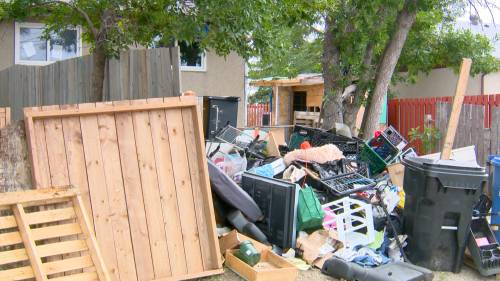The Marlborough house that keeps neighbours up at night sits nestled between well-kept homes on a quiet residential street. For over three years, residents have watched this property transform from a typical family dwelling into what they describe as a neighborhood nightmare.
“I’ve lived here for 22 years, and I’ve never seen anything like this,” says Marion Kowalski, whose backyard faces the property in question. “The constant stream of people at all hours, the yelling, the garbage – it’s affecting our sense of safety.”
The property, located on Marbank Drive NE, has become notorious among residents for suspected drug activity, excessive noise, and property neglect. According to community reports, police have responded to the address more than 30 times since January 2023 alone.
Calgary Police Service confirms they’re well aware of the location. Staff Sergeant Keith Silvester of District 4 acknowledges the situation has become a significant concern for area residents. “We understand the frustration neighbors are experiencing. These problematic properties require a coordinated approach across multiple city departments and sometimes take longer to resolve than anyone would like.”
What’s particularly troubling for residents is the property’s proximity to Marlborough Elementary School, just three blocks away. Parents have reported finding discarded needles and drug paraphernalia along routes children take to school.
“My kids used to walk to school, but not anymore,” explains resident Jeff Tomkins. “We drive them now because we don’t trust what they might encounter. That’s not how a neighborhood should function.”
The property owner, identified through city records as Theodore Merkl, doesn’t live at the address. Attempts to reach Merkl for comment were unsuccessful. Records show the property has accumulated over $5,000 in bylaw infraction fines over the past year.
City Councillor Raj Dhaliwal, who represents Ward 5 where Marlborough is located, says he’s working with various departments to address the issue. “We’re utilizing every tool available to us, from property standards enforcement to coordinating with police. These situations are complicated by legal protections for tenants and property owners, but public safety must take precedence.”
The Calgary Safer Communities and Neighbourhoods (SCAN) unit, which investigates problem properties, confirmed they’ve received multiple complaints about the address but couldn’t comment on specific enforcement actions underway.
For residents like Doris Chen, who’s lived across the street for 15 years, the situation has dramatically changed her perception of the community. “Marlborough used to be a place where neighbors knew each other. Now we’re all just focused on protecting our homes and families.”
Local community association president Martin Reilly believes the situation highlights broader challenges in neighborhood enforcement. “When it takes years to address a property that’s clearly problematic, something’s broken in the system. Communities shouldn’t have to suffer through endless documentation and reports while their quality of life deteriorates.”
The issue of troubled properties isn’t unique to Marlborough. Across Calgary, similar scenarios play out in neighborhoods from Forest Lawn to Dover. City data shows complaints about suspected drug houses increased 28% between 2021 and 2023.
For now, residents continue documenting incidents, filing reports, and attending community meetings. They’ve created a neighborhood watch group and installed additional security measures on their own properties.
“We shouldn’t have to live like this,” says Kowalski. “Everyone deserves to feel safe in their own home.”
As winter approaches, residents worry the situation will worsen, with people potentially seeking shelter in the house during colder months. They’re planning to attend the next city council meeting to voice their concerns directly to officials.
Until permanent action is taken, Marlborough residents remain in limbo – caught between their attachment to a community they’ve called home for decades and the daily stress of living next to a property that threatens their sense of security and well-being.







